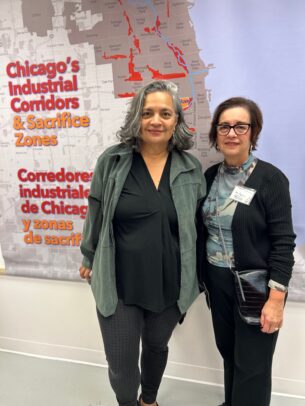Climates of Inequality exhibition opens at Chicago Justice Gallery

The Chicago Climates of Inequality exhibition, featuring stories of environmental justice and community resilience, was organized by the UIC Rafael Cintrón Ortiz Latino Cultural Center and Social Justice Initiative in partnership with community organizations Alianza Americas and Little Village Environmental Justice Organization.
The exhibit’s grand opening, held in mid-October, featured speakers from the partner organizations, faculty and students that helped curate the exhibit.
Rosa Cabrera, executive director of the Latino Cultural Center, explained that the full traveling exhibition is a project of the Humanities Action Lab that has been four years in the making with over 500 students, educators and environmental justice leaders in more than 20 cities across the U.S., including Puerto Rico, Colombia and Mexico.
“The exhibition here today represents seven stories out of 22,” said Cabrera, explaining that the gallery’s space made it necessary to scale down the original exhibit.
“The story in Chicago focuses on Little Village, and there are two panels here highlighting the systematic cycles of environmental injustice affecting this community. This was curated by students in my environmental and social justice class who collected stories from residents in this neighborhood,” she said.
“One of the important things about the exhibition is that it centers climate change as a social justice issue,” Cabrera said. “We expanded to other Chicago sacrifice zones beyond Little Village to affirm the work that these dedicated communities continue to do. They have been fighting systematic environmental harms while creating practical solutions that they have been putting in place to lessen these harms.
Cabrera explained that sacrifice zones are areas located in Chicago’s industrial corridors with high levels of pollution, causing long-term health risks to residents who are mostly Black and Latinx low-income earners.
During her remarks, Cabrera encouraged everyone to learn about Hazel M. Johnson, recognized as the mother of the environmental justice movement. Cheryl Johnson, Hazel’s daughter, was present at the grand opening.
View more information about the exhibit and viewing schedule.
Categories
